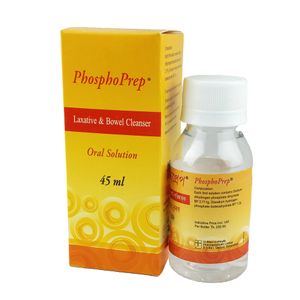Phosphoprep Uses, Dosage, Side Effects and more
Sodium phosphate can be used in the management of hypophosphataemia. It also acts as a mild osmotic laxative when given orally as dilute solutions or by the rectal route. Phosphate enemas or concentrated oral solutions are used for bowel cleansing before surgery or endoscopy procedures.

| Attribute | Details |
|---|---|
| Trade Name | Phosphoprep |
| Generic | Sodium Dihydrogen Phosphate Dihydrate + Disodium Hydrogen Phosphate Dodecahydrate |
| Weight | (2.711 gm + 1.2gm) / 5ml, (2.711 gm+1.2gm)/5ml |
| Type | Oral Solution |
| Therapeutic Class | Enema & bowel cleansing solution |
| Manufacturer | Unimed Unihealth Mfg, Ltd, D16 Pharma & Biotec (mfg, By: Unimed Unihealth) |
| Available Country | Bangladesh |
| Last Updated: | January 7, 2025 at 1:49 am |
Uses
This is an stable clear, colorless, buffered, ginger-lemon flavored, aqueous oral solution, that is used to treat relief of occasional constipation, bowel cleansing regimen in preparing the patient for surgery or for preparing the colon for X-Ray or endoscopic examination.
Dosage
Dose for bowel preparation-
Adults and children 5 years of age & over:The recommended dosage for adults andchildren 5 years of age & over is 45 ml andrepeated 10 to 12 hours later. The intake ofclear liquids is an essential part of thisregimen. On the day before the procedure,the patient should only take clear liquidsfor breakfast, lunch and dinner andbetween doses. No solid food, milk or milkproducts should be taken on the daybefore the procedure. The patient shouldnot drink anything colored red or purple.Medical procedure is intended to beperformed at early morning, mid-morningor later, by two alternative dosageregimens.
Early morning procedure:The first dose is taken at 7 a.m. on themorning before the procedure. The seconddose is taken at 7 p.m. on the eveningbefore the procedure.
Mid-morning (or later) procedure:The first dose is taken at 7 p.m. on the evening before the procedure. The second dose is taken at 7 a.m. (or at least 3 hours before leaving for the appointment) on the morning before the procedure.
- First dose: Mix 15ml (one third of thebottle) of This into a full glass(approximately 250ml) of clear liquids anddrink. Repeat two more times within thenext 20 minutes.
- Between Doses: Between the first andsecond doses, the patient should drink atleast three more glasses (approximately250 ml each) of clear liquids or more ifdesired to prevent dehydration and toensure that their bowel remains easilyexaminable for the procedure.
- Second Dose: Mix 15 ml of Thisinto a full glass of clear liquid and drink.Repeat two more times within the next 20minutes. Please refer to clear liquids listbelow. Beverages, water, tea or coffee (nomilk or non dairy creamer), sweeteners areacceptable, carbonated or non carbonatedsoft drinks (not colored red or purple) fruitflavored cordials (not colored red or purple)and strained fruit juices without pulp. Donot drink any alcoholic beverage.
Dose for occasional constipation-Adult/child over:
- 12 years old: 20-45 ml
- 10-11 years old child: 10-20 ml
- 5-9 years old child: 5-10 ml
Side Effects
Gastrointestinal side effects of sodium biphosphate and sodium phosphate have included bloating (31% to 41%), nausea (26% to 30%), abdominal pain (23% to 25%), and vomiting (4% to 9%). Nervous system side effects have included dizziness, headache, and seizures. Renal side effects have included renal impairment, increased blood urea nitrogen (BUN), increased creatinine, acute renal failure, acute phosphate nephropathy, nephrocalcinosis, and renal tubular necrosis. Hypersensitivity reactions reported have included anaphylaxis, rash, pruritus, urticaria, throat tightness, bronchospasm, dyspnea
Precaution
This solution should be used with extreme caution, in the elderly, the frail or debilitated, patients with colostomy and this solution patients on a low salt diet, as they are particularly at risk. These patients should receive additional fluids by mouth, both prior to, and after administration of this solution, to ensure that dehydration does not occur. Patients undergoing major bowel procedures, who are on nil by mouth for significant periods of time, should have their electrolytes monitored and receive intravenous fluids containing potassium and calcium, prior to surgery. Use with caution in patients taking diuretics and in patients using medicines known to prolong the QT interval. Concurrent administration of polyethylene glycol bowel cleansing preparations and this solution may be dangerous and is not recommended. Patients should be advised not to use this solution when nausea, vomiting or abdominal pain are present, unless directed by a physician.
Interaction
Use with caution in patients taking calcium channel blockers, diuretics, angiotensin converting enzyme inhibitors (ACE-Is), angiotensin receptor blockers (ARBs), non-steroidal anti-inflammatory drugs (NSAIDs), and lithium preparations or other medication that might affect electrolyte levels, as hyperphosphataemia, hypocalcaemia, hypernatraemic dehydration and acidosis may occur. Concurrent administration of polyethylene glycol bowel cleansing preparations and this solution may be dangerous and is not recommended.
Pregnancy & Breastfeeding use
Use in pregnancy: Because of potential harm to the fetus from phosphate absorbed across the placenta, the use of this product is not recommended in pregnant women unless the probable clinical benefit outweighs the possible risk.
Use in lactation: Because of potential harm to the infant from phosphate excreted in breast milk, the use of this product is not recommended in nursing mothers unless the probable clinical benefit outweighs the possible risk.
Contraindication
CHF, renal failure or clinically significant impaired renal function, congenital or acquired megacolon, bowel/GI obstructions, ascites, perforation of ileus, active inflammatory bowel disease.
Special Warning
Use in children: This is not to be taken by children under 5 years of age.
Use in diabetics: As the liquid diet during the period of administration and prior to bowel surgery, X-Ray of the colon or colonoscopy may affect the diabetic patients’ glucose blood levels, adjustment of their insulin or oral anti-diabetic medication may be necessary.
Storage Condition
Store in a cool and dry place, procted from light. Keep out of children’s reach.



